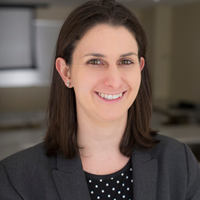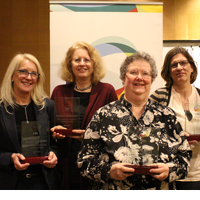Inside MERL: Making Innovation Happen
Mitsubishi Electric Research Labs (MERL) is a Lab and Center member of CRA. This article is the third in a series of our industry member profiles. MERL sponsors the CRA Outstanding Undergraduate Researcher Award in alternate years, along with Microsoft Research.

Mitsubishi Electric Research Labs (MERL) is the North American subsidiary of the corporate research and development organization of Mitsubishi Electric Corporation. MERL conducts application-motivated basic research and advanced development in areas important to Mitsubishi Electric. With 63 researchers, MERL is small enough to be flexible and agile, while gaining leverage from our global parent Mitsubishi Electric.
Stable, long-term funding provides us with the freedom to choose aggressive long-term goals and make foundational scientific contributions. We turn our technical achievements into impacts on the world by partnering with the tens of thousands of researchers and engineers in Mitsubishi Electric’s operations around the world.
MERL is home to world-leading experts in six main areas. Underlying all of our work is physical modeling and simulation. Without a clear understanding of the physics underlying a problem, it is very difficult to make progress. Much of MERL’s day-to-day research involves signal processing (including audio, video and other sensor data processing, and compressive sensing); control (of electromechanical systems); and optimization (both generating optimal plans and optimal control to follow those plans). These capabilities combine to produce Artificial Intelligence systems (including computer learning, computer vision, and speech recognition). Lastly, most of MERL’s output is in the form of new algorithms; our specialty is producing highly efficient algorithms for solving complex problems in real-time.
Our overriding vision is delivering innovation that will be remembered 100 years from now. For more than 25 years we have produced cutting-edge technological advances, fundamentally rethinking a number of problems and delivering radical improvements.
We focus on a high level of collaboration both within our staff and with the wider scientific community. The publication of our research output is highly encouraged, as is participating in a variety of activities, such as serving on editorial boards, technical committees, and conference program committees.
We maintain close relationships with key universities and collaborate with leading academic research groups in our areas of interest. A central aspect of our relationship with universities is our graduate student internship program. The internship program provides students with the type of experience that helps them enhance and accelerate their professional careers, while also contributing to initiatives at MERL and helping us to identify good researchers to hire. Although we host students throughout the year, the main influx of students is during the summer when our research staff doubles as students from all over the world arrive at our Cambridge, Mass., office.
Seven Examples of MERL’s Scientific Research
The following examples illustrate the wide range and importance of research at MERL.
Optical Communication
MERL researchers developed a new multi-subcarrier transceiver technology that experimentally achieved a capacity of 1 Tbps using a single optical receiver. Spectral efficiency of 9.2 b/s/Hz was achieved, which was a world record for single receiver 1 Tbps transmission. A key feature of MERL’s approach is the use of a pilot signal to enable high-quality compensation for signal impairment over a fiber. MERL’s technology is compatible with currently installed optical fiber systems, allowing for a smooth upgrade path.
Railway Energy Conservation
A key problem with regenerative power in electrified railway systems is that standard systems maintain all the substations at a constant voltage near the maximum voltage the wires can support. This significantly limits the amount of power than can flow from a breaking train to an accelerating one. Mitsubishi Electric developed equipment that can vary the voltage at each substation in real-time. MERL developed an algorithm to optimize the voltage at the substations so that the flow of power from one train to another can be maximized. In a simulated experiment, this enabled a 5% reduction of total railway energy consumption.
Representing Surfaces in 3D Space
MERL developed a novel representation for surfaces in 3D space called Adaptively Sampled Distance Fields (ADFs). Polygonal graphics representations explicitly define the surface of an object. Distance fields describe a surface via parametric mathematical functions defining the distance between each point in space and the nearest part of the surface. ADFs use a detail-directed adaptive partitioning of space and can represent very high levels of detail, using much less memory than polygonal approaches and allowing some calculations to be much more efficient. ADFs have been applied to Computer Numerical Control (CNC) milling to create extremely accurate simulations of a complex cutting program that can reveal minute details of the milled surface to help diagnose errors in the program.
Virtual Environments
In 1995, MERL demonstrated a multi-user virtual environment called Diamond Park that supported multiple geographically separated participants interacting in a 3D virtual world. This was the first virtual reality system capable of supporting real-time spoken interaction between participants. More importantly, it was the first to support the arbitrary modification and extension of the environment during continuous operation, which are essential features of today’s massive online gaming environments.
Spacecraft Trajectories
MERL has developed an end-to-end trajectory design framework for space missions to the moon and beyond using 3-body gravitational dynamics. Small resonant perturbations from the moon’s gravity can increase the size of a spacecraft’s orbit even when it is far from the moon’s primary sphere of influence. Additionally, there are pathways in the earth-moon system through which a spacecraft can transit from an Earth orbit to a moon orbit, without using any fuel. MERL has computed trajectories that can save up to 7% of fuel while reaching the moon in only five months. Since fuel weight is a large fraction of total spacecraft weight, a 7% fuel savings enables a 10x increase in payload.
Computer Reasoning
Belief Propagation is a message-passing algorithm for performing inference on graphical models. The basic Belief Propagation algorithm works well most of the time; however, while it often produces the correct result when applied to a cyclic graph, it doesn’t always do so. This is unfortunate since most graphs encountered in real-world situations are cyclic. In 2000, MERL researchers pioneered the development of Generalized Belief Propagation algorithms that are guaranteed to work on every graph. This work triggered the start of a new sub-field of research that continues to this day.
Speech Processing
One of the central problems of speech processing is being able to separate out one voice from a mixture of many voices. This is something the human auditory system does well, but computer systems do not do well. For 15 years, MERL has pioneered advances in source separation. Combining originality with solid theoretical foundations, MERL’s methods have dramatically influenced the field and solved problems that were previously out of reach. Some of our current developments are based on a fundamentally new way to use domain knowledge as the basis for novel deep-learning architectures. We believe our latest technology is poised to solve the general audio-separation problem, opening up a new era in spontaneous human-machine communication.
About the Author
Richard C. Waters received his Ph.D. from the MIT AI lab and worked there for 13 years before becoming a founding member of MERL in 1991. At MERL, he worked on multiuser virtual reality systems before becoming MERL’s president and CEO in 1999. As president, he combined what had been multiple small research labs in the U.S. into a single unified lab and has nurtured that lab to become Mitsubishi Electric’s premier long-range research laboratory.
About Mitsubishi Electric’s Research Division
 Mitsubishi Electric’s research division has more than 2,000 researchers in five labs in four countries. The labs conduct both long-range fundamental research and applied development for Mitsubishi Electric’s wide range of business areas, including HVAC, auto parts, elevators, factory automation, optical and wireless communication, high-power semiconductors, satellites, railway transportation, and electric generation, transmission and distribution. For more information about Mitsubishi Electric Research, see www.mitsubishielectric.com/company/rd/. For more information about MERL, see www.merl.com.
Mitsubishi Electric’s research division has more than 2,000 researchers in five labs in four countries. The labs conduct both long-range fundamental research and applied development for Mitsubishi Electric’s wide range of business areas, including HVAC, auto parts, elevators, factory automation, optical and wireless communication, high-power semiconductors, satellites, railway transportation, and electric generation, transmission and distribution. For more information about Mitsubishi Electric Research, see www.mitsubishielectric.com/company/rd/. For more information about MERL, see www.merl.com.



